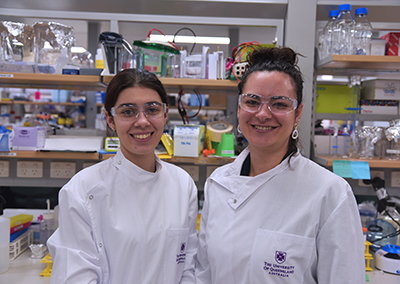Here's a sweet science analogy for you. You feel hungry and weak, so you open a packet of peanuts.
Strangely, there are also jellybeans in the packet.
Eating a handful of this mix seems to do the trick though and, before long, you start to feel better.
But was it the peanuts or the jellybeans that made the difference? And should others repeat this strategy if they need an energy boost?

Granted, this is a scenario you will not see play out in the AIBN laboratories.
But this analogy is a good parallel for the latest work that the Wolfram Group is doing in the field of extracellular vesicles - small fat bubbles that carry messages in the body.
There has been a huge increase in studies on extracellular vesicles, as these biological ‘text messages’ can be harnessed to develop therapeutic and diagnostic approaches for diseases, such as cancer.
However, postdoctoral fellow Dr Jenifer Pendiuk Goncalves and PhD student Raluca Ghebosu say there are a few issues preventing a comprehensive understanding of extracellular vesicles and inter-study reproducibility in the field.
A major issue in the field is the variable presence of extracellular vesicle contaminants, notably a widely overlooked polysaccharide known as hyaluronic acid.

Jenifer and Raluca say this particular polysaccharide (a long chain of sugars) is a potential red herring when it comes to quantifying the functional effects of extracellular vesicles and, ultimately, paving the way for new biological understanding, therapies, and diagnostics.
“When people are isolating extracellular vesicles to study them, they are aware that there are some contaminants – molecules that should not be there,” Jenifer says.
“But we have found that among these contaminants, there is a class of molecules nobody is looking at, the polysaccharides. And these molecules have several known biological effects.
“So if you are ignoring the polysaccharides, you do not know the scope of their influence on the overall study, or whether they are influencing anything at all.”
In the Journal of Extracellular Vesicles – the best journal in the field and an official journal of the International Society for Extracellular Vesicles – Jenifer and Raluca call on their colleagues to consider the implications of extracellular vesicle-bound and contaminant polysaccharides, including hyaluronic acid.
“We have been able to show, for the first time, that this polysaccharide is a contaminant in extracellular vesicle samples when we isolated them using different methods,” Raluca says.
“So we want the field to be more aware of co-isolated polysaccharide contaminants, which could be responsible for some effects incorrectly attributed to extracellular vesicles.”
Or in other words, perhaps it was the unexpected jellybean contaminants that made the difference, and not the peanuts.
The paper was co-authored by Wolfram Group researchers Xuan Ning Sharon Tan, Dr Dalila Iannotta, and Associate Professor Joy Wolfram, as well as Dr Na'ama Koifman from the Centre for Microscopy and Microanalysis at The University of Queensland.



